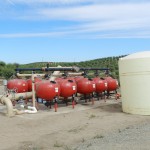
No one knows where the rumor started, and so far no one’s been able to confirm it—the story around Stanislaus County is that the aquifer has started flowing uphill.
Implausible as it may seem, the tale is based on growing awareness of just how many giant pumps are operating twenty-four hours a day in the eastern portion of the County. Over the last decade or so, land that once featured only cattle grazing and dry land farming has been planted with trees, mostly almonds.
The numbers are stunning: hundreds of thousands of trees have been planted on tens of thousands of acres. In fact, of the eighty-thousand or so acres of irrigated land added in Merced and Stanislaus Counties over the last dozen years, most have been in eastern Stanislaus County.
A few years ago, no one would have thought it possible to turn this dry land green, especially during summer. That was before the big players in farming began noticing the handsome profit margins in almonds. They also noticed that one of the last great untapped aquifers in the San Joaquin Valley lay right here in Stanislaus County.
Presto! Cattlemen whose ranches had been in the family for generations were suddenly receiving buyout offers at unimaginable prices. Those few who held out saw their ranches encircled with acre after acre of almond groves.
The saplings soon began to grow at phenomenal rates. As always with California miracles, the magic ingredient was water. Those with money enough to purchase tens of thousands of trees at five dollars each also had the capital to buy state-of-the-art pumping systems ranging from 200 to 400 horsepower.
Behemoths designed to haul water from more than three-hundred feet under the ground, the pumps are equipped with filters that remove the sand that would clog up the sophisticated drip-irrigation systems that water the trees. The pumps also mix in the fertilizer that pushes the trees to maximum growth and production levels. Experts estimate most of the pumps are pushing water at a rate of 2000 gallons a minute, twenty-four hours a day.
Today’s advances in horticulture enable growers to measure water and fertilizer proportions almost to the exact last gallon necessary for a tree’s most efficient performance. One unintended consequence is that irrigation water is used so efficiently by the trees that there’s none left to recharge the aquifer.
To get an idea of the consequences when groundwater is used so intensively, consider what’s happened to the High Plains Aquifer. A vast underground ocean that extends from Wyoming and South Dakota into Kansas and south to the Texas panhandle, the aquifer is rapidly being depleted in its southern reaches. Pumps that once produced 1600 gallons of water a minute are now running at 300 gallons a minute or less. All this has happened within a generation, and it’s happened with an aquifer of far greater depth and extent than the one Stanislaus County.
Given that the average life of an almond orchard is twenty-five years, and given the enormous investments so far, it’s clear the new orchard owners are figuring on water lasting at least through the life span of an orchard. To a limited extent, one expert agrees with them.
Dr. Vance Kennedy is a retired hydrologist who worked for the U.S. Geological Survey. Kennedy estimates the water table at current usage is dropping two feet per year. He also knows that the deeper wells have to go to find water, the more expensive costs are for the grower. At some point, and Kennedy thinks that point will come sooner than later, the grower must let the trees die or face accelerating financial losses.
At first glance, one would think the losses thereafter apply only to the grower, but such thinking is short-sighted. Aquifers are the result of decades of slow accumulation of water. Once they’re depleted to levels hundreds of feet down, the recharge is lifetimes away. That means the land above the aquifer is essentially useless except for very limited purposes.
Given the history of aquifers that have been subjected to intensive agricultural uses, there’s no question that the Stanislaus County aquifer will be exhausted beyond economic uses. The only real question is when it will cease to function to anyone’s benefit. Many Valley citizens are starting to realize Vance Kennedy’s projections are unfortunately more likely right than wrong. The depleted aquifer will almost certainly be a reality sooner than most people think.
Next: “Green is the Color of Money.”

It’s amazing to me that this issue isn’t getting more attention. It’s been known for a quarter century at least that portions of the San Joaquin Valley have subsided by more than 20 feet. I would be surprised if they get more than one rotation of almonds out of this, and who knows how much damage to other agriculture and the environment in general will result?
Some east side residents are already reporting they’ve had to drill deeper for the first time in decades. The depletion is already evident, and as John says, we have plenty of evidence of what happens when we overdraft.